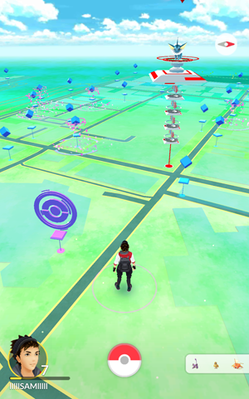Some tips for our new mappers coming from Pokémon GO:
Please,
- do improve the map!
- do map things that exist on the ground. The map is used by pedestrians, people with disabilities, cyclists, hikers, canoeists, drivers and others. Do not add things -such as footways- that do not exist
- do add things you see (i.e. benches, cafes, fire hydrants, bicycle parking spots) or things you know (if your favorite cafe offers free wifi, the type of cuisine of the nearby diner, accessibility, opening hours, official websites, wikipedia links)
- want to add footways? Check what is considered as a footway: highway=footway tag docs. Want to add other features? Have a look at map features and search the wiki
- do connect your footways with the road network
- tagging secondary institutions? Use amenity=school. Tagging universities? Use amenity=university
- do you still have questions? Ask away at help.openstreetmap.org
- do connect with the community! Find your country’s forum, mailing list/twitter account or other contact channel
- do not add copyrighted data from other maps/sources
- do find other mappers that improve your neighborhood/city e.g. with the oooc map (you need to have contributed a bit before your nickname is shown)
- do check your own stats after you have contributed a bit! e.g. here
- do check existing events
- do mention “pokemon” in your changeset comments and a few words about what you added/changed. That will help your neighbor mappers to check the changes you make and maybe provide tips
- do contribute your GPS traces, especially if you live in a rural area
- do check the good practice guidelines for more tips
You and over three million of other contributors make OpenStreetMap possible. Welcome to our community – be excellent to each other and enjoy mapping our pale blue dot!
Pokémon Go?
 We’ve recently seen a flurry of new map editing activity from “Pokémon GO” players. Although this hugely popular mobile game displays maps from google maps (in fun colours), it seems it may be using OpenStreetMap data (according to some players) to influence “spawn points” within the game.
We’ve recently seen a flurry of new map editing activity from “Pokémon GO” players. Although this hugely popular mobile game displays maps from google maps (in fun colours), it seems it may be using OpenStreetMap data (according to some players) to influence “spawn points” within the game.
This is interesting for several reasons. We always like to see creative and unexpected uses of our free and open map data, and this certainly fits into that category! (Note: our open license does require crediting OpenStreetMap)
There is some new interest in editing the map from Pokémon GO players, presumably because the game is found to be bringing in updates when changes are made to OpenStreetMap. It always takes new folks some time to get to know OpenStreetMap, and we hope Pokémon GO players will stick around to contribute some more. We’ve prepared the above guidelines to help understand some aspects of OpenStreetMap related to the game.
OpenStreetMap is a world-wide collaborative project aiming at providing free map data, under an open license, to anyone who wants it. Volunteers all over the planet contribute their local knowledge and their time to build the best map ever.
You can contribute by improving the map, editing or translating the wiki, becoming a member of the volunteer Working Groups, increasing awareness about the project, uploading GPS traces, donating (donate.openstreetmap.org) or joining the OSM Foundation. You don’t have to be a member of the Foundation in order to edit OpenStreetMap.
This post is also available in: German Japanese Portuguese (Portugal) Croatian Ukrainian

Pingback: Tips for new (Pokemon Go) mappers - Pokemon Go Tips and Tricks
Pingback: Savjeti za nove (Pokemon Go) kartografe – OpenStreetMap Hrvatska
Pingback: weeklyOSM 337 | weekly – semanario – hebdo – săptămânal – haftalık – 週刊 – týdeník – edisi
The box at the top should mention that footways should be connected to the rest of the network.
But leaving this information away has also a positive effect: Pokémon mappers can be recognized easier.
You might also want to read the recommendations for new (Pokémon GO) mappers by community members.